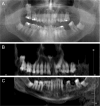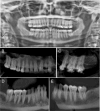E-dentification, the use of teledentistry for remote personal forensic identification in forensic odontology: a Queensland experience
- PMID: 40822626
- PMCID: PMC12356368
- DOI: 10.1093/fsr/owaf016
E-dentification, the use of teledentistry for remote personal forensic identification in forensic odontology: a Queensland experience
Abstract
Dental comparison is recognized by the International Criminal Police Organization as one of three primary forensic identification techniques that can provide conclusive findings. Queensland is a large Australian state with a centralized forensic odontology service located at Queensland Health's Coronial and Public Health Sciences (CPHS) in Brisbane, which sits in the state's South-Eastern corner. Almost half of the Queensland population is located outside of Brisbane, and the distance to regional centres can be very large. Transporting forensic dental personnel and their equipment to these regional centres to undertake identification and examination procedures can be both expensive and time-consuming, depriving CPHS of service for the period of absence. The acquisition of post-mortem computed tomography (PMCT) data locally in regional centres with remote access electronically from CPHS in Brisbane has the potential to alleviate these issues in many cases. Forensic radiographers at CPHS work with forensic odontologists to produce multi-planar reformat images from PMCT data, which simulate common dental radiographs such as orthopantomogram, bitewing, and periapical views. Additional images, such as three-dimensional (3D) reconstructions of the teeth and jaws, can also be produced and viewed from various angles. These multi-planar reformat and 3D images can be compared with antemortem (AM) radiographic images and dental records of a missing person sourced from public or private dental surgeries, public hospitals, or private radiology practices. Comparisons can be made not only with AM traditional dental radiographs but also with images and reconstructions produced from AM dental cone-beam computed tomography or medical computed tomography data. The authors term this remote dental identification "e-dentification". While e-dentification offers numerous advantages, there are several limitations to its use, including access to the necessary equipment, the consistent acquisition of high-resolution PMCT data, and artefacts, including those due to metal restorations, that may be present in computed tomography images. We present four cases to illustrate and discuss e-dentification.
Keywords: computed tomography; forensic identification; forensic odontology; radiology; teledentistry.
© The Author(s) 2025. Published by OUP on behalf of the Academy of Forensic Science.
Figures




References
-
- Geoscience Australia . Area of Australia – States and Territories. Australian Government. [cited 5 Oct 2022]. Available from: https://www.ga.gov.au/scientific-topics/national-location-information/di...
-
- Queensland Treasury. Queensland Population Counter. Queensland Government . [cited 5 Oct 2022]. Available from: https://www.qgso.qld.gov.au/statistics/theme/population/population-estim...
-
- Australian Bureau of Statistics . Regional Population 2021-2022 Financial Year. Australian Government; [cited 20 Jun 2023]. Available from: https://www.abs.gov.au/statistics/people/population/regional-population/...
-
- INTERPOL . INTERPOL Disaster Victim Identification Guide. INTERPOL, 2018. [cited 5 Oct 2022]. Available from: https://www.interpol.int/en/content/download/589/file/18Y1344%20E%20DVI_...
Publication types
LinkOut - more resources
Full Text Sources

